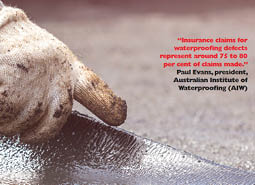Waterproofing is a process critical to prevent the destruction of building elements, but when it comes to the workmanship behind the process, there’s still much room for improvement. By Tracey Porter.
No-one really knows just how big the issue of waterproofing failures is but it’s safe to say it’s closer to a tidal wave than a trickle. If a waterproofer fails to do his or her job properly, water ingress can cause the destruction of building elements including rotting of timbers, concrete cancer and rusting of steel components. While its main purpose is to resist hydrostatic pressure exerted by moisture in the liquid state, if the level of waterproofing is inadequate, mould spores may develop. In all area of dampness where there is a lack of adequate ventilation and spores are allowed to multiply, there is a very real chance of chronic health problems—such as reduced lung function and asthma—developing in all those living or working nearby. Paul Evans, the president of voluntary industry group Australian Institute of Waterproofing (AIW), admits the “stats are slim” in regards to the magnitude of waterproofing failures and can vary greatly depending on their source.
“We have a rough appraisal based on [Australian developers] insurance claims for waterproofing defects (prior to the recent bushfires, floods and storms) and they represent around 75 to 80 per cent of claims made.”
Get it right the first time
Fosroc waterproofing and sealant segment manager, Colin Picton, agrees with the figures quoted by Evans and says the reasons for this are varied but are typically caused by poor planning, selection, preparation, application, time allowed and aftercare. “Right first time may seem costly up front, however it is significantly cheaper than retro solutions after the fact,” Picton says. Evans, whose membership group is drawn from waterproofing contractors, manufactures and re-sellers of waterproofing products, engineers, architects, builders and other trades around Australia, says preparation is a critical element of waterproofing and often short-changed or overlooked in the urgency to get a project’s timeline to “work with a Gantt chart” or to push a stage of works forward to enable a progressive payment to a builder.
“Some will say ‘it looks dry enough— go ahead and waterproof fit mate’ when in reality the concrete substrate may hold a substantial amount of water,” Evans says. “When a membrane system is applied over this, the water vapour tries to escape through the membrane and will create bubbling or pin holing which can (in some cases) compromise the membrane.”
All on the surface
A surface for waterproofing needs to be dry and free of surface defects such as holes or cracks. The usual way to prepare a surface is to fill all deviations first with a suitable filler (compatible with the membrane) and allow the fillers to cure—then apply primers or a first coat of membrane, he says. But any waterproofing membrane is only as good as the surface to which it is applied or installed, and good tradespeople know there are a number of checks that must be made first.
Picton agrees substrate preparation is a key element of the success of a waterproofing. “It goes without saying that surfaces must be clean, sound, stable and free of loose foreign material, existing coatings, laitance, release agents, curing compounds and oil/grease residues,” he says. Before any membrane can be applied, the surface must be adequately primed. Priming can be used to alleviate moisture from pushing through a new membrane (usually a two part epoxy primer) or some primers are for keying into the surface of a substrate to enhance the bond of the membrane system being installed.
Product selection
Picton says correct product selection is also a critical part of ensuring successful waterproofing. A good membrane should provide resistance to methane, carbon dioxide and radon gases as well as providing enhanced durability of the structure against chlorides and sulphates, found in many parts of Australia, he says. Both agree that when done by a suitably qualified tradesman, a typical waterproofing job should last between 20 to 30 years before requiring further maintenance.
However, a significant cause of the issues with waterproofing is that each method of preparation will differ from project to project and the judgment is left to individuals who do not have enough knowledge of the process, Evans says. The Australian Standards used in waterproofing are mainly governed by AS-3740-2010 (domestic wet areas), AS-4654-2010 (external above ground waterproofing), AS-4858 (wet area membrane selection/performance/ preparation) and AS-3598.2-2007 (guide to selection of tiling materials).
There is currently no below ground standard for waterproofing in Australia however the AIW is actively writing a guide for this that it hopes will be adopted by Standards Australia in the future. Evans says the AIW is doing all it can to encourage its members to go well beyond these standards and ensure the systems being installed are suitable for the purpose and will be a long-term solution to preventing water ingress to a building. Evans says he regrets that AIW is something of a “toothless tiger” when it comes to policing poor waterproofing workmanship as it does not have any way of reprimanding a member, aside from cancelling the membership, a move he admits would only be taken “in an extreme case”.
Despite this, the industry body is doing all it can to help improve the overall standards of waterproofers nationally and recently teamed with the Master Builders of Victoria to develop a waterproofing course for the likes of supervisors, builders, specifiers, engineers, architects, and designers to hone their skills in “real life” waterproofing including what they need to be looking for when having works carried out correctly.






